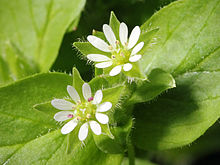Chickweed
| Common chickweed | |
|---|---|
 |
|
| Flowers of the common chickweed | |
| Scientific classification | |
| Kingdom: | Plantae |
| (unranked): | Angiosperms |
| (unranked): | Eudicots |
| (unranked): | Core eudicots |
| Order: | Caryophyllales |
| Family: | Caryophyllaceae |
| Genus: | Stellaria |
| Species: | S. media |
| Binomial name | |
|
Stellaria media (L.) Vill. |
|
| Synonyms | |
Alsine media L.
Stellaria Apetala Ucria ex Roem.
Stellaria media, chickweed, is a cool-season annual plant native to Europe, but naturalized in many parts of North America. It is used as a cooling herbal remedy, and grown as a vegetable crop and ground cover for both human consumption and poultry. It is sometimes called common chickweed to distinguish it from other plants called chickweed. Other common names include chickenwort, craches, maruns, winterweed. The plant germinates in autumn or late winter, then forms large mats of foliage.
The plants are annual and with weak slender stems, they reach a length up to 40 cm. Sparsely hairy, with hairs in a line along the stem. The leaves are oval and opposite, the lower ones with stalks. Flowers are white and small with 5 very deeply lobed petals. The stamens are usually 3 and the styles 3. The flowers are followed quickly by the seed pods. This plant flowers and sets seed at the same time.
Stellaria media is widespread in North America, Europe and Asia. There are several closely related plants referred to as chickweed, but which lack the culinary properties of plants in the genus Stellaria. Plants in the genus Cerastium are very similar in appearance to Stellaria and are in the same family (Caryophyllaceae).Stellaria media can be easily distinguished from all other members of this family by examining the stems. Stellaria has fine hairs on only one side of the stem in a single band and on the sepals. Other members of the family Caryophyllaceae which resemble Stellaria have hairs uniformly covering the entire stem. It usually has 3 stamens other references indicate 5 stamens and 3 - 8 in other references.
Very common as a weed in waste places.
The larvae of the European moth yellow shell (Camptogramma bilineata), of North American moths pale-banded dart (Agnorisma badinodis) or dusky cutworm (Agrotis venerabilis) or North American butterfly dainty sulphur (Nathalis iole) all feed on chickweed.
...
Wikipedia
